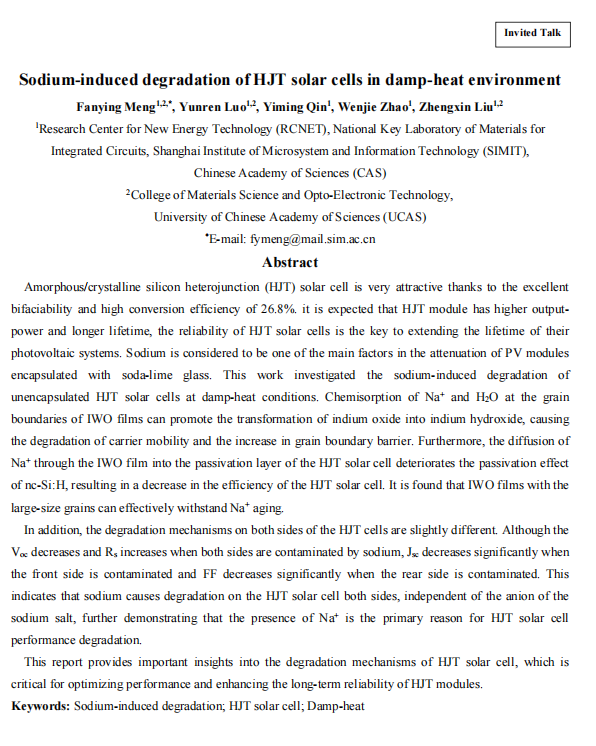| Sodium-induced degradation of HJT solar cells in damp-heat environment【孟凡英】 |
| 发布时间:2025-09-23 | 浏览次数:171 |
Sodium-induced degradation of HJT solar cells in damp-heat environment Fanying Meng1,2,*, Yunren Luo1,2, Yiming Qin1, Wenjie Zhao1, Zhengxin Liu1,2 1Research Center for New Energy Technology (RCNET), National Key Laboratory of Materials for Integrated Circuits, Shanghai Institute of Microsystem and Information Technology (SIMIT), Chinese Academy of Sciences (CAS) 2College of Materials Science and Opto-Electronic Technology, University of Chinese Academy of Sciences (UCAS) *E-mail: fymeng@mail.sim.ac.cn Abstract Amorphous/crystalline silicon heterojunction (HJT) solar cell is very attractive thanks to the excellent bifaciability and high conversion efficiency of 26.8%. it is expected that HJT module has higher output-power and longer lifetime, the reliability of HJT solar cells is the key to extending the lifetime of their photovoltaic systems. Sodium is considered to be one of the main factors in the attenuation of PV modules encapsulated with soda-lime glass. This work investigated the sodium-induced degradation of unencapsulated HJT solar cells at damp-heat conditions. Chemisorption of Na+ and H2O at the grain boundaries of IWO films can promote the transformation of indium oxide into indium hydroxide, causing the degradation of carrier mobility and the increase in grain boundary barrier. Furthermore, the diffusion of Na+ through the IWO film into the passivation layer of the HJT solar cell deteriorates the passivation effect of nc-Si:H, resulting in a decrease in the efficiency of the HJT solar cell. It is found that IWO films with the large-size grains can effectively withstand Na+ aging. In addition, the degradation mechanisms on both sides of the HJT cells are slightly different. Although the Voc decreases and Rs increases when both sides are contaminated by sodium, Jsc decreases significantly when the front side is contaminated and FF decreases significantly when the rear side is contaminated. This indicates that sodium causes degradation on the HJT solar cell both sides, independent of the anion of the sodium salt, further demonstrating that the presence of Na+ is the primary reason for HJT solar cell performance degradation. This report provides important insights into the degradation mechanisms of HJT solar cell, which is critical for optimizing performance and enhancing the long-term reliability of HJT modules. Keywords: Sodium-induced degradation; HJT solar cell; Damp-heat
|






